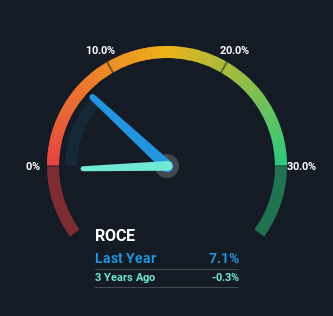Investors Met With Slowing Returns on Capital At AstroNova (NASDAQ:ALOT)
If you're looking for a multi-bagger, there's a few things to keep an eye out for. Amongst other things, we'll want to see two things; firstly, a growing return on capital employed (ROCE) and secondly, an expansion in the company's amount of capital employed. Basically this means that a company has profitable initiatives that it can continue to reinvest in, which is a trait of a compounding machine. Although, when we looked at AstroNova (NASDAQ:ALOT), it didn't seem to tick all of these boxes.
Understanding Return On Capital Employed (ROCE)
If you haven't worked with ROCE before, it measures the 'return' (pre-tax profit) a company generates from capital employed in its business. Analysts use this formula to calculate it for AstroNova:
Return on Capital Employed = Earnings Before Interest and Tax (EBIT) ÷ (Total Assets - Current Liabilities)
0.071 = US$7.1m ÷ (US$133m - US$33m) (Based on the trailing twelve months to July 2023).
So, AstroNova has an ROCE of 7.1%. On its own, that's a low figure but it's around the 7.6% average generated by the Tech industry.
Check out our latest analysis for AstroNova
Historical performance is a great place to start when researching a stock so above you can see the gauge for AstroNova's ROCE against it's prior returns. If you'd like to look at how AstroNova has performed in the past in other metrics, you can view this free graph of past earnings, revenue and cash flow.
How Are Returns Trending?
There hasn't been much to report for AstroNova's returns and its level of capital employed because both metrics have been steady for the past five years. This tells us the company isn't reinvesting in itself, so it's plausible that it's past the growth phase. With that in mind, unless investment picks up again in the future, we wouldn't expect AstroNova to be a multi-bagger going forward.
What We Can Learn From AstroNova's ROCE
In a nutshell, AstroNova has been trudging along with the same returns from the same amount of capital over the last five years. And investors appear hesitant that the trends will pick up because the stock has fallen 27% in the last five years. On the whole, we aren't too inspired by the underlying trends and we think there may be better chances of finding a multi-bagger elsewhere.
AstroNova does come with some risks though, we found 2 warning signs in our investment analysis, and 1 of those is significant...
While AstroNova isn't earning the highest return, check out this free list of companies that are earning high returns on equity with solid balance sheets.
Have feedback on this article? Concerned about the content? Get in touch with us directly. Alternatively, email editorial-team (at) simplywallst.com.
This article by Simply Wall St is general in nature. We provide commentary based on historical data and analyst forecasts only using an unbiased methodology and our articles are not intended to be financial advice. It does not constitute a recommendation to buy or sell any stock, and does not take account of your objectives, or your financial situation. We aim to bring you long-term focused analysis driven by fundamental data. Note that our analysis may not factor in the latest price-sensitive company announcements or qualitative material. Simply Wall St has no position in any stocks mentioned.

